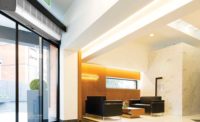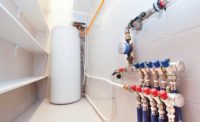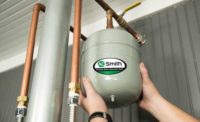According to the U.S. Environmental Protection Agency, HVAC accounts for 26% of a commercial business’s energy usage, which can lead to hefty utility bills. That means finding greener ways to heat a building isn’t just trendy for environmental reasons; it’s also a useful way to save a buck.
A number of current heating trends reflect the industry-wide push toward more energy-efficient systems.
Geothermal: A green heating trend
Geothermal systems have a unique advantage compared to traditional heating systems: They use the earth for thermal storage, to both extract and expel heat. A system with the right water table and soil compositions can extract heat from the earth all winter and return heat to it in the summer, storing it there from one season to the next.
Because geothermal is an all-electric, motor-based technology, buildings that have both a geothermal system as well as a way to collect green electricity (e.g., solar panels) essentially can consume no fossil fuels, making them especially environmentally friendly.
Geothermal also can integrate with hydronic systems, which are efficient because water is an effective way to move a large volume of energy across hundreds of feet of building space. Using air, instead, requires very large ducts and a lot of electrical energy in the fan and there is a high possibility of air leakage. Moving thermal energy using water often requires only 3- to 4-inch pipes, even for a big facility, with less motor energy required and less energy leakage while in transit.
More green heating trends
A common trend in the hydronic design world is to become more energy efficient by reducing pumps’ electrical consumption. This has been achieved in the past by using more efficient motors on pumps, specifically variable-frequency drive motors, and more recently, electrically commutated motors. Now there is a trend toward firetube boiler technology, which removes boiler pumps and their associated motors entirely from the system.
In a traditional boiler plant, each individual boiler has a pump of its own. These can be made more efficient by using VFD motors or ECMs, but using a firetube boiler instead means the boiler becomes part of the main system loop with the large pumps for the whole building becoming responsible for the boilers as well. Having fewer motors is the preferred green design principle in LEED certification requirements.
Outdoor reset controls are another green initiative. Although these have been around for a while, and many larger commercial facilities already have them, there now is a greater awareness of the value the technology offers for all facilities and more manufacturers are incorporating them into their products.
Outdoor reset controls allow heat to flow smoothly from heat emitters, continuously and at the right rate. They adjust the temperature supplied to the building, modifying the rate at which rooms warm up to match the rate at which they are cooling, which varies according to what the outdoor temperature is, and the whole system’s efficiency grows.
A third trend is in controls capacity and connectivity. It’s now common — and sometimes required — that equipment in a commercial facility, including boilers, can talk to the building-management system as well as to each other, so the building only runs as many boilers as needed at any given time. Equipment such as boilers and heat pumps report firing rate, alarms and their status to the BMS.
Some connected technologies allow every heat pump or boiler in the building to be monitored and controlled from one screen — advanced operational oversight that barely was possible 10 years ago and now is commonplace and only becoming more so.
Finally, integrating a variety of equipment to create multi-energy (“hybrid”) facilities has become especially common on the heating side. This entails mixing and matching fuels or energy sources for what makes sense for a particular facility.
For example, a facility might have a geothermal system primarily designed for cooling loads that also will heat for as long as possible in the winter. This might not be enough for the heating load in some northern climates, so there also would be a natural-gas condensing boiler that operates at the lower water temperatures common in geothermal systems, providing the remaining heat required to ensure occupants of the building are comfortable, while only burning as much fuel as needed.
Some facilities also might have cast-iron boilers as reserve equipment to back up the natural gas boilers in certain circumstances. The general trend is toward efficiency, but lots of facilities (e.g., hospitals) require backup fuels on site and fuel oil is popular for its ease of storage.
Tips and tricks
Some best practices for specifying and installing green-heating systems for a commercial building include:
-
Make sure the equipment is appropriately sized for the system. Historically, boilers and heating/cooling equipment have been oversized for redundancy, but engineers now are designing systems for the actual energy requirements of a building. If it’s too large, it will cycle on and off all the time, which is inefficient. This also is important in the case of geothermal because oversizing a geothermal system inflates capital costs.
-
True redundancy is achieved by having more units, not just bigger ones, because redundancy comes not just from capacity, but also from the number of stages. For example, hospitals and schools may need 100% redundancy in the equipment on hand. If the required load is calculated to be 2 million Btu/h, then they need 4 million Btu/h of heat capacity. If a hospital uses two boilers with 2 million Btu/h each to achieve this, taking one offline leaves only one piece of equipment operational, which presents a precarious position.
If instead it has four boilers with 1 million Btu/h, taking one offline still leaves 50% overage. If two are offline, the hospital has its design capacity available, and if three are being serviced, the hospital still has half the design load, which still provides enough heat for most of the year.
ASHRAE guidelines indicate that a typical facility operates at 60% of the design load or less for 90% of the year, and 50% of the load or less for 80% of the year, so multiplying equipment rather than upsizing serves redundancy needs much better. All equipment gets smaller; capital costs for geothermal technology (in the case of a hybrid facility) and installation costs generally go down; and efficiency increases as equipment will cycle less often, but with even more redundancy available.
-
When working with fuel-fired products, don’t select any equipment until you’ve determined how it will be vented. No regulations are more restrictive than venting, so it’s important to look at venting before going too far down the design path.
While commercial buildings now have a number of options to make their heating systems greener, the products available will continue to become more efficient as technologies improve, ensuring building owners enjoy lower electrical bills, and engineers who can specify and install these products will be rewarded with plenty of work.



